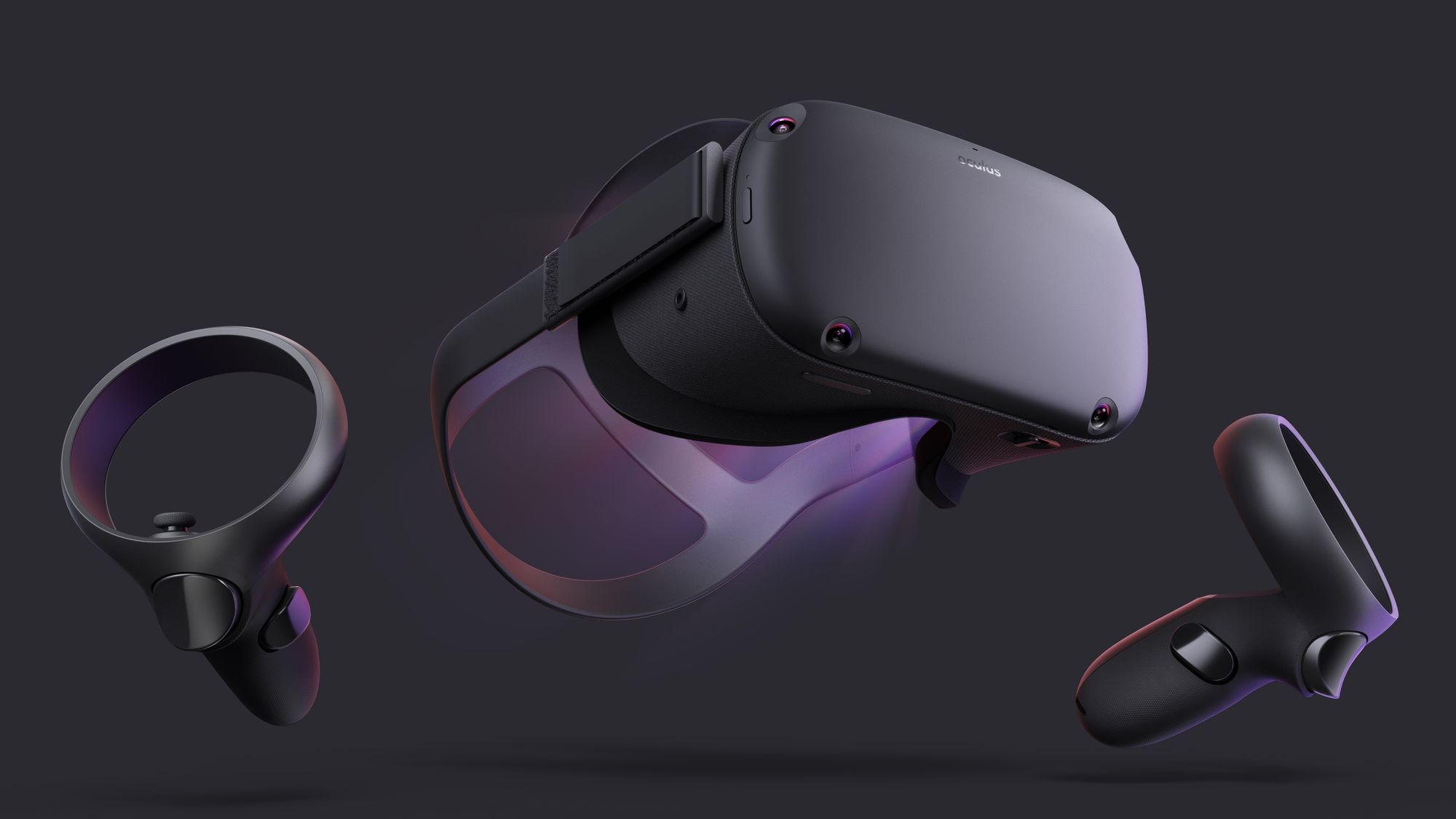I moved my workspace to VR, here's what I learnt
I spent a month working full time in virtual reality. Is the tech there yet? Is it comfortable to use VR? Should we all switch to $500 headsets from the $1500+ displays? Here are the answers.

Hello everybody! I decided to finally give virtual reality a go and to replace my boring corner with 3 real displays with something more interesting. I decided to run all of my development from VR for at least a month. This article contains all the experience I've gained. This article was also written in VR!

Just to compare, this is a pic of my current setup. It's pretty good already. Three displays, one of them is vertically oriented (which is kind of a life-hack because you can use it as two displays if you position your windows correctly). Noteworthy things are my "convertible" standing desk and the way I use Magnet macOS app shortcuts to quickly "snap" the windows into correct positions.
The desk is made of a typical cheap corner tabletop from IKEA and five cheap table legs with the cheap Lack, table legs of which I shortened. This way I can quickly switch between a standing desk with a 90-degrees elbow angle and a relaxed sitting position. However, I cannot remember the last time I used my chair. I'm just to lazy to "convert" the space back to the sitting mode.
Displays are also placed on the mounts that can slide up and down to adapt to the correct viewing angle. Magnet macOS app has been a lifesaver. There are probably good free alternatives, but I paid for Magnet a while ago and still use it. I also have an external keyboard and a trackpad.



And this is a pic of my current setup. Yep, you can notice, that not many things changed. In particular, the screens are now off, I have an Oculus Quest and I've moved my MacBook to a safe place near my router, connected it through ethernet and ran the Immersed app to set up my virtual reality workspace.
The Immersed macOS app is the key to this setup. Without it and its virtual displays, the whole adventure would be worthless. At the moment of writing, they only fully support virtual displays for macOS, but the developers are extremely active and will probably add full virtual displays support to Windows sometime soon. Currently, you have to have physical displays attached to the computer on Windows to have them appear in VR.
I was taking notes while using VR as my primary environment to write code and they became the breadcrumbs I used to write the following portion of the article. This is why it can be a bit all over the place, I apologize in advance. Let's get to what I liked, disliked or found interesting about VR and some advice on how to survive in VR.
- Buy simple moisturizing eyedrops. I don't know why, but eyes dry up way faster in VR. Maybe because I keep my eyes open for longer periods. It just feels more comfortable not to blink in a VR headset for some reason.
- The Immersed app is great, but my router wasn't good enough to support a good low-latency connection between the Oculus Quest headset and my MacBook on the Immersed app. For the reference, I use Mi Router 3. I kept getting lags. Officially, the best solution to solve it is to buy a small WiFi dongle for ~$50 and connect to Oculus Quest with the Direct WiFi. I am too cheap for this so I bought an Ethernet adapter for the MacBook and connected it directly to the router. Now I don't have any lags at all. Also, rebooting MacBook helps in some severe lag cases.
- You need to have good skills in blind-typing. I've switched to Colemak recently and had to relearn to type from ground up, so it was a no brainer for me. If you need to look at the keyboard, you will have a hard time using VR.
- VR is still expensive. I paid 480CAD for my Oculus Quest brand new in box on Facebook Marketplace, but it is still cheaper than buying a set of 3 cool displays (this is how many displays I have in my virtual space). Honestly, I don't even know if you can connect 3 external displays to a MacBook.
- The resolution is still too low. It does not compare to even having 1080p displays. It is almost like having multiple 720p 40" displays. I find reading text being not terrible at all, but still not good enough to "enjoy" it. This is also partially why I would suggest buying Oculus Quest instead of Oculus Go (which turned out to be a mistake — Oculus Go is better for reading text as it is LCD and not OLED). After a while you get used to it, so I'll keep using it. However, if you can't stand low resolution, wait until something better is released!

- One of the obvious upsides is how far away and secure my MacBook is. Having fixed it 4 times after spilling something over the MacBook, I find this extremely calming. I physically cannot harm the MacBook anymore.
- Because of the resolution issues, you cannot simply put a couple of 30" displays around you as you usually do. Most likely, you will have a set of 40"-60" displays uncomfortably close to you in VR. Uncomfortable only at first, obviously — you'll get used to it.
- You will be forced to break more often, which is a good thing. After a while, your eyes are going to fully adapt to VR, but your head will still feel a bit uncomfortable if you spend more than 2 hours straight in VR no matter how good the mounting method is. My Mi Band 4 reminds me if I spend more than an hour without any activity.
- Make sure to do an eyesight test before you start to work in VR — and 1-2 months after you begin your journey. If you see any noticeable deterioration, it might mean that VR isn't for you, unfortunately. However, my eyesight (I've got 20/20) doesn't feel like it is getting worse — but I'm yet to take my second eye exam! Also, research on this topic cannot find any negative eyesight effects of VR.
- There is no dizziness when using VR. I've heard that some people experienced it before but I haven't felt anything like it.
- I did experience some form of motion sickness though but only when I played VR games that allow a player to move around by pressing buttons and not by physically moving. Something inside the brain cannot connect the dots: it looks like you're moving, but physically you don't move an inch. If you use alternative modes of movement (usually provided in the games) like teleportation or physically moving — it should be enough to get rid of motion sickness. Needless to say, if you're just working stationary, there are no issues at all.
- Games in VR are freaking awesome. They are so immersive that I forget I'm in VR. Especially the free Echo VR. Just look at the footage below. It's mind-blowing. I once hit the virtual ceiling in this game and had to crouch because it felt like I was going to physically hit it.
- Keep in mind that spending too much time in VR will leave temporary marks on your face since there is a VR headset positioned on your face. So probably don't plan any social events 10-20 minutes after you take off your headset.
- I use Oculus Quest which doesn't require any cables at all. This allows me to turn on the see-through feature of the headset (when you can use cameras in Oculus to see what's around you in real life) and go make a cup of coffee without taking the headset off. This feature is decent, there is no lag between movements and the picture. However, I still use this urge to eat and drink to take breaks from VR.
- There is more than enough charge to not worry about it. Especially if you charge your VR headset during the breaks.
- You can also play games like Beat Saber during the breaks. It helps you to maintain the activity level. I also use Beat Saber before working out to warm up.
- There are no issues with sweating when you are just working in VR. I haven't experienced any issues with sweating or fogging inside the headset while playing active games either.
- Eating and drinking are difficult (which can be a good thing, eating in front of displays is generally a bad idea), however, you can use a straw to drink comfortably in VR. VR headsets physically make it difficult to eat.
- The headset gets warm after a while. It's not uncomfortable in any way but it is noticeable.
- Due to the way optics is structured in Oculus Quest if you have a bright light in front of you in VR (e.g. the video above with the mountains where I work) you will see some kind of a flare, like on a sunny day in real glasses. This is the reason I almost always have the dark mode everywhere and my background is usually a dimmed star constellation rather than the bright mountains.
- Bluetooth headphones are now supported, however, I end up using 3.5 headphone jack in the headset or the built-in speakers. I don't know why people don't like the built-in speakers, they do make it feel like you're surrounded by the sounds in a good way.
- Make sure to carefully adjust the mounting straps. I had to spend some time getting the right configuration between them being too tight or too loose. If you overtighten them, you'll get headaches, if they are too loose, you'll lose focus and everything will look blurred.
Conclusion
So, should you switch to VR office space instead of the good old displays? Well yes, but not entirely.
Pros:
- You aren't attached to your workspace, you can work anywhere with the powerful and familiar setup of your virtual displays. You can travel and still be productive from any size of a hotel room.
- If your home is not decorated in a cozy way or if you face walls while working (like I do), then VR can be a great cheat-code escape.
- There is physically no way to spill anything over your expensive computer.
Cons:
- Have to know how to blind-type.
- The resolution is not yet acceptable for most.
As you can see, having only two noticeable disadvantages from which blind-typing is not an issue for me and resolution is acceptable, I'll keep using VR as my office, especially when traveling. As soon as the next generation of VR headsets hits the markets with the Micro LED technology presented on CES 2020, I'll upgrade my setup and update this article.
All in all, resolution is the only thing that keeps me from working in VR full time now. I still write code on my physical displays and sometimes enjoy the sun in a chair on my balcony working on just my MacBook.
I cannot recommend switching your developers to VR yet, but in 2-5 years I expect to see the next breakthrough in VR tech that will end all doubt and allow us to fully transition to the VR office space.
See you later, alligator!

